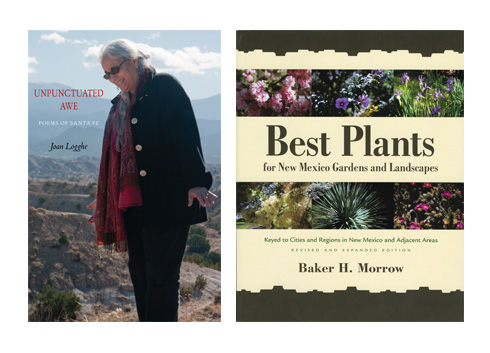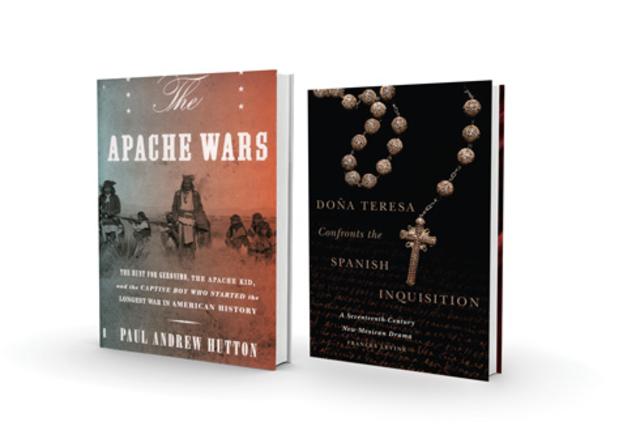THE APACHE WARS:
The Hunt for Geronimo, the Apache Kid, and the Captive Boy Who Started the Longest War
in American History
BY PAUL ANDREW HUTTON (Crown, 2016)
Reaching the midpoint in The Apache Wars, by Paul Andrew Hutton, it becomes clear this 19th-century conflict could have no effective cease-fire or lasting armistice. Moments of hope for ending the bloodshed pass quickly, mere lulls in a massive storm system. The war would end only when the tsunami of Manifest Destiny prevailed.
Written by an accomplished historian of the Southwest, this book is an important contribution to boosting everyone’s understanding about the consequences of the longest war in the nation’s history, which slashed an enduring cultural and historical scar across New Mexico and Arizona.
The conflicts between the Apaches and white settlers were so numerous that it is hard to pinpoint when what are considered the wars actually began. Hutton settles on 1861, when Apaches from the Aravaipa band raided a ranch in Arizona’s Sonoita Valley and kidnapped a one-eyed, 11-year-old boy with bright red hair. Raised by the Apaches, the boy became widely known as Mickey Free and eventually returned to work as a scout for the U.S. Army. But his kidnapping served as a pretext for almost continuous warfare until the defeat of the Apaches in the 1890s.
Using Free as the narrative thread, Hutton traces every aspect of the conflict across 514 pages. The author, a professor of history at the University of New Mexico, interweaves his rendering of the battles with revealing accounts of slavery, so common in New Mexico that Indian slaves were considered a form of trade currency; gold mining, which induced feverish behavior among white settlers; and the creation of reservations that resembled hospices—a place of confinement for a dying people.
A simple truth, Hutton explains, fueled the Apache resistance even to humanitarian efforts on their behalf. To the Apache people, assimilation was but another form of slavery. But from the perspective of many whites, the Apaches’ continued inhabitation of the Southwest was not a feasible outcome.
Hutton tells a sorrowful tale. By its end, Mickey Free comes to understand—in the author’s words—“the bottomless depths of the white man’s perfidy.”
The incredible number of people populating this expansive history is, at times, overwhelming. And for the faint of heart, Hutton’s description of the brutal acts of both white and Native people will be hard to take. Nonetheless, Hutton, a prolific author and frequent figure in documentaries, has written what will certainly be long regarded as a definitive history of the almost three-decades-long war between Apaches and white Americans.
—James McGrath Morris
DOÑA TERESA CONFRONTS THE SPANISH INQUISITION:
A Seventeenth-Century New Mexican Drama
BY FRANCES LEVINE (University of Oklahoma Press, 2016)
A power struggle between church and state turned personal when the Spanish Inquisition came knocking at the doors of the Palace of the Governors in Santa Fe in 1662. Doña Teresa Aguilera y Roche got swept up in a religious roundup of supposed “secret Jews” that resulted from political enmity between a top church official and her husband, Bernardo López de Mendizábel, the outgoing governor. It didn’t help that the first lady’s own unfamiliar and haughty ways on Spain’s remote frontier nurtured an urge among her household staff to see her brought down a notch or two.
Frances Levine, a former director of the New Mexico History Museum/Palace of the Governors, draws on a trove of documents to bring the time alive, from an inventory of Doña Teresa’s possessions at the time of her arrest to the woman’s own vigorous writings from her Mexico City prison cell, in which she proclaims her innocence and takes vicious aim at her suspected accusers. We are able to imagine the sumptuous fabrics of her dresses and draperies and her frequent enjoyment of chocolate drinks, as well as to hear, in tones ranging from piteous pleadings to angry denunciations, the voice of a woman determined to clear her name.
We also learn the supposedly juicy details that fueled the tribunal’s suspicions: claims that she did not adequately adhere to her religious duties, along with tales about the educated and literate daughter of privilege laughing while reading a book written in Italian, keeping a drawer of her desk locked, sleeping behind locked doors with her husband with only a young girl to attend them—actions that sound laughably mundane in our time but caused some to wonder what she was hiding.
In telling the tale of this remarkable woman, Levine lifts the veil on a little-known history of the Spanish Inquisition’s reach into the New World, including colonial New Mexico. Levine provides the background of the times to show how people who fled Spain after its 1492 expulsion of Jews once again found religious authorities probing their piety and their bloodlines, investigations that could be spurred by whispers and gossip among those eager to seek revenge or their own advantage.
Bolstering the book is an exhibition at the New Mexico History Museum, Fractured Faiths: Spanish Judaism, the Inquisition, and New World Identities, through December 31.
—Jackie Jadrnak

UNPUNCTUATED AWE:
Poems of Santa Fe
BY JOAN LOGGHE (Tres Chicas Press, 2016)
Joan Logghe has a way with words, and her way wraps them around and weaves them through myriad experiences that constitute life in northern New Mexico. In Unpunctuated Awe, that life centers on Santa Fe, where Logghe served as the city’s third poet laureate, from 2010 to 2012.
Her tenure inspired a sequence of poems about place, which are collected in this lovely, slim book. In it, Logghe reflects on more than 40 years in her adopted home of northern Santa Fe County. One measure of a poet is the ability to universalize from the particular, and Logghe has mastered that craft. She honors the everyday, finding both solace and wistful heartache in the passage of time. Her voice speaks for anyone in love with New Mexico, challenged by its foibles, puzzled by its contradictions, entranced by its majestic landscape, and enthralled by its cultural heritage.
Logghe approached the poet laureate role as an unfettered journalist, writing 100 poems in free verse. “I wrote for a city,” she says in her opening note, scribbling “occasional” poems—about occasions—in a pocket notebook. “The city was rife with poems.” Hers are shorn of rhyme and meter yet plush in rhythm and imagery. Pointed and keenly observed, the poems embrace a wide range of experiences of life in and around Santa Fe. Always focusing on the concrete and specific, Logghe revels in the metaphors that “grow literal in this land.”
Logghe’s subject matter ranges widely. She writes about pancake breakfasts and Rail Runner rides, the Fourth of July and Labor Day, Indian Market and modern art. She writes about red chile and tumbleweeds, aging and April, drought and fire, dancing and art. And she writes about people: “Rose of Chimayó and Beatrice Maestas Sandoval of colcha,” a tattooed young woman in a troupe of belly dancers, Georgia O’Keeffe, friends, and strangers.
There’s action too: “Last night on the Plaza I danced. / The Plaza was painted by Breughel. / The man who bought my mother’s car was there. / There was flirting as befits a summer night. / The drinks were stronger than they had any right. / My grandkids were lively as salt on the rim.”
With a clean, simple design by J.B. Bryan, who has probably published more poetry than anyone in New Mexico through his La Alameda Press imprint, the book starts with a brief author’s introduction and proceeds to the poems, with section breaks featuring Logghe’s full-page brushwork paintings. These simple, powerful, Zen-inspired images are sometimes abstract, sometimes starkly representational, always the perfect visual counterpoint to her well-chosen words, which are encapsulated in her question: “Is it possible to be too alive?”
Read Unpunctuated Awe for pleasure and give it to friends who ask you what Santa Fe and its environs are really like. Admittedly, it’s one version of Santa Fe, viewed through Logghe’s sharp lens. Others can write the book about the native-born’s Santa Fe, the art dealer’s Santa Fe, the Los Alamos commuter’s Santa Fe. But no one can capture this slice of life in the City Different better than Joan Logghe. Her poems remind us what’s great about being alive—and why we need poets.
—Charles C. Poling
BEST PLANTS FOR NEW MEXICO GARDENS AND LANDSCAPES
BY BAKER H. MORROW (UNM Press, 2016)
When I began landscaping my construction-scarred yard in Placitas, I nearly wore out Baker H. Morrow’s Best Plants for New Mexico Gardens and Landscapes. First published in 1995, it earned this update, thanks to all that horticulturalists and landscape architects such as Morrow have learned in the 21 years since. Whether you’re a beginner or a Master Gardener, there’s plenty to like in its 286 pages, including tips on soil health, irrigation, historic designs, and lists of which plants might do well in a shady spot, which in full sun, and which in a patch of soil by a city street.
A good half of the book is devoted to the geographically dissimilar planting conditions across the state and even in tricky places like Albuquerque, where a West Mesa gardener faces struggles that a North Valley gardener doesn’t.
Photographs are small and utilitarian. The writing is tight and informative. Pick it up before you head to the nursery.
—Kate Nelson


